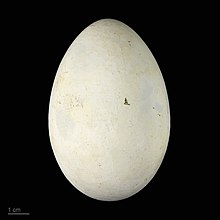Cape boobies
| Cape boobies | ||||||||
|---|---|---|---|---|---|---|---|---|

Cape gannets on the coast of South Africa |
||||||||
| Systematics | ||||||||
|
||||||||
| Scientific name | ||||||||
| More capensis | ||||||||
| ( Lichtenstein , 1823) |
The Cape gannet ( Morus capensis ) is a nearly goose-sized sea bird from the gannet family . In its appearance it is reminiscent of bass and austral gannets .
Appearance
The Cape Booby reaches a body length between 85 and 94 centimeters. The wings have a length of 45 to 51 centimeters. The wingspan is 171 to 185 centimeters. They weigh between 2.29 and 3.29 kilograms. Males tend to be slightly larger than the females.
The body plumage of adult Cape Boobies is predominantly white. The head and neck are washed over yellow, although this yellow color varies both individually and seasonally. The wings are black except for the innermost. The tail plumage is also usually completely black. The beak is blue-gray and separated from the head plumage at the base of the beak by a narrow strip of unfledged black skin. The eyes are pale gray. The eye ring is blue and the feet and legs are blackish. Young birds are predominantly brown-gray and have white spots on their heads and necks. This spot is more noticeable on the mantle and the wing covers. From the second to fourth year of life, the young birds become increasingly lighter, but usually keep their dark chest.
There is a possibility of confusion with the Australian booby . The Cape Booby can only be distinguished from this species at close range. In the Australian booby, however, only the middle tail feathers are black. Another distinguishing feature is the black throat stripe that runs vertically from the base of the beak towards the chest. This black stripe is more pronounced and longer in the Australian gannet. The Cape Booby also has the paler iris.
distribution
Cape gannets breed off the coast of Namibia and South Africa . From the very rare and today only on the Christmas Island brooding Abbott's Booby apart, no other Tölpelart has a smaller area in which the breeding colonies are (z. B .: in Bird Iceland Nature Reserve ). Similar to the guano booby , the distribution obviously depends on a nutrient-rich ocean current that carries cold water. This so-called Benguela Current is also decisive for the distribution of other sea birds.
Cape boobies occasionally also reach the Australian continent as random visitors . Individual Cape gannets have been detected several times in a bay near Port Phillip in breeding colonies of the Australian gannet, and ringed Cape gannets have been caught off the Western Australian coast in South Africa. Since the cape booby can only be distinguished from the Australian booby up close, it is possible that cape boobies reach Australia relatively regularly.
Systematics
It is generally accepted knowledge to assign the species of the booby family to the three genera Morus , Sula and Papasula . Within this classification, the Cape gannet belongs to the genus Morus, together with the Australian gannet and the northern gannet . The following cladogram gives the results of the molecular analysis by Friesen and Anderson, which confirm this division:
| Sulidae (boobies) |
|
||||||||||||||||||||||||||||||||||||||||||||||||
|
|
The ornithologist Bryan Nelson has suggested that the Cape gannet and the Australian gannet be regarded as allospecies of the superspecies northern gannet . The Australian gannet differs from the Cape gannet only in a slightly smaller, featherless area around the eyes, a darker iris and the black color of the four central tail feathers. Hybridization with Kaptölpeln occurs occasionally.
supporting documents
literature
- PJ Higgins (Ed.): Handbook of Australian, New Zealand & Antarctic Birds . Volume 1, Ratites to Ducks, Oxford University Press, Oxford 1990, ISBN 0-19-553068-3 .
- Josep del Hoyo et al .: Handbook of the Birds of the World. Volume 1: Ostrich to Ducks. Lynx Edicions, 1992, ISBN 84-87334-10-5 .
- Bryan Nelson: The Atlantic Gannet. Fenix Books, Norfolk 2002.
- Bryan Nelson: Pelicans, Cormorants and their relatives. Oxford University Press, 2005, ISBN 0-19-857727-3 .
- Hadoram Shirihai: A Complete Guide to Antarctic Wildlife - The Birds and Marine Mammals of the Antarctic Continent and Southern Ocean. Alula Press, Degerby 2002, ISBN 951-98947-0-5 .
Single receipts
- ↑ a b Shirihai, p. 208.
- ^ Higgins, p. 749.
- ^ VL Friesen, DJ Anderson: Phylogeny and evolution of the Sulidae (Pelecaniformes: Aves): a test of alternative nodes of specification. In: Molecular Phylogenetics and Evolution. 1997, No. 7, pp. 252-260.
Web links
- Morus capensis inthe IUCN 2013 Red List of Threatened Species . 2. Listed by: BirdLife International, 2012. Retrieved February 2, 2014.


